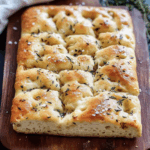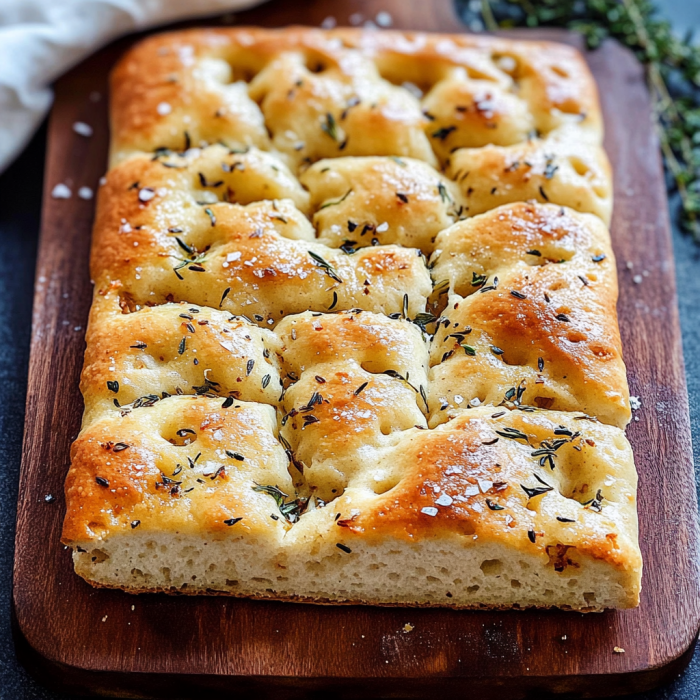If you’ve ever had the pleasure of enjoying a slice of focaccia, you know it’s more than just bread. This Italian classic is soft, flavorful, and perfect as a side or even as a meal on its own. Whether you’re an experienced baker or a novice in the kitchen, making focaccia from scratch is easier than you might think. Here’s how to create the perfect focaccia, bursting with flavor and texture.
What is Focaccia?
Focaccia is a traditional Italian flatbread that has a rich, olive-oil-infused flavor and a soft, airy texture. It can be seasoned with a variety of toppings, including herbs, olives, onions, and garlic, making it incredibly versatile. Often compared to pizza dough, focaccia is thicker and more bread-like, with a delightful crust and a tender crumb.
Ingredients for Perfect Focaccia
To make the best focaccia, you’ll need the following ingredients:
- Flour: 500 grams (about 4 cups) of all-purpose flour.
- Water: 325 ml (about 1⅓ cups) of warm water.
- Olive Oil: 60 ml (about ¼ cup) plus extra for drizzling.
- Yeast: 2 teaspoons of active dry yeast or instant yeast.
- Salt: 1½ teaspoons of salt.
- Sugar: 1 teaspoon of sugar (to activate the yeast).
- Toppings: Fresh rosemary, sea salt, and optionally, sliced olives, cherry tomatoes, or caramelized onions.
Instructions
- Activate the Yeast: In a small bowl, mix the warm water with the sugar and yeast. Let it sit for about 5-10 minutes, or until it becomes frothy.
- Prepare the Dough: In a large mixing bowl, combine the flour and salt. Make a well in the center and pour in the activated yeast mixture and olive oil. Mix until the dough begins to come together.
- Knead the Dough: Transfer the dough to a lightly floured surface and knead for about 8-10 minutes until smooth and elastic. If the dough is too sticky, add a little more flour, a tablespoon at a time.
- First Rise: Place the dough in a lightly oiled bowl, cover it with a damp cloth or plastic wrap, and let it rise in a warm place for about 1-2 hours, or until doubled in size.
- Shape the Dough: Once risen, punch the dough down to release any air bubbles. Transfer it to a greased baking pan (a 9×13 inch pan works well) and use your fingers to spread it out evenly. Dimple the surface of the dough with your fingertips.
- Second Rise: Cover the dough again and let it rise for another 30-45 minutes, or until it puffs up.
- Preheat Oven: While the dough is rising, preheat your oven to 220°C (425°F).
- Add Toppings: Drizzle the top of the dough with olive oil. Sprinkle with fresh rosemary and sea salt. You can also add sliced olives or cherry tomatoes if desired.
- Bake: Bake the focaccia for 20-25 minutes, or until the top is golden brown and the bread sounds hollow when tapped.
- Cool and Serve: Let the focaccia cool slightly before cutting into squares or slices. Enjoy it warm or at room temperature.
Tips for Perfect Focaccia
- Use High-Quality Olive Oil: Since olive oil is a key ingredient, using high-quality extra-virgin olive oil will enhance the flavor.
- Don’t Rush the Rising: Allowing the dough to rise properly ensures a light and airy texture.
- Experiment with Toppings: Feel free to get creative with toppings like caramelized onions, cheese, or roasted garlic.
Serving Suggestions
Focaccia is incredibly versatile. Serve it as an appetizer with dipping oils, alongside soups and salads, or as a delicious sandwich base. It also makes a great accompaniment to pasta dishes or can be enjoyed on its own with a bit of butter or cheese.
Conclusion
Making focaccia at home is a rewarding experience that fills your kitchen with the irresistible aroma of freshly baked bread. With this easy-to-follow recipe, you can enjoy a delicious, homemade focaccia that rivals any bakery. Perfect for any meal or occasion, this focaccia will quickly become a favorite in your baking repertoire.
Serving and Storage Tips for Focaccia
Serving Tips:
- Warm or Room Temperature: Focaccia is best enjoyed warm or at room temperature. If you’ve stored it in the fridge, reheat it in the oven for a few minutes to restore its crispness.
- Pairings: Serve focaccia as a side with soups, salads, or pasta dishes. It’s also great for dipping into olive oil, balsamic vinegar, or your favorite sauces.
- Sandwiches: Use focaccia as a hearty base for sandwiches. Add fillings like grilled vegetables, meats, cheeses, or spreads for a delicious and satisfying meal.
- Appetizers: Cut focaccia into bite-sized pieces and serve as an appetizer with antipasti or charcuterie boards.
- Garnishes: Top with additional fresh herbs, a sprinkle of sea salt, or a drizzle of flavored olive oil before serving to enhance flavor and presentation.
Storage Tips:
- Room Temperature: Store leftover focaccia at room temperature, wrapped in a clean kitchen towel or plastic wrap, to keep it fresh for up to 2 days.
- Refrigeration: If you need to store focaccia for a longer period, place it in an airtight container or resealable bag in the refrigerator. It will stay fresh for up to a week, but note that refrigeration can make the bread slightly dry.
- Freezing: For longer storage, freeze focaccia. Wrap it tightly in plastic wrap and then in aluminum foil, or place it in a freezer-safe bag. Focaccia can be frozen for up to 3 months. To thaw, leave it at room temperature or reheat it in the oven.
- Reheating: To refresh the focaccia, preheat your oven to 180°C (350°F) and warm the bread for 5-10 minutes. This will help restore its crispness and flavor.
By following these serving and storage tips, you can ensure your homemade focaccia remains delicious and versatile, ready to complement any meal or occasion.
1. How can I make my focaccia more flavorful?
To enhance the flavor of your focaccia, experiment with different toppings and seasonings. Adding fresh herbs like rosemary, thyme, or basil, as well as ingredients like olives, cherry tomatoes, or caramelized onions, can elevate the taste. You can also incorporate garlic or onion powder into the dough for added flavor.
2. Why did my focaccia turn out dense and heavy?
A dense and heavy focaccia could be the result of several factors. Ensure that you’re using fresh yeast and giving the dough enough time to rise properly. Over-kneading the dough or using too much flour can also lead to a dense texture. Make sure the dough is soft and slightly sticky before letting it rise.
3. Can I use whole wheat flour instead of all-purpose flour for focaccia?
Yes, you can use whole wheat flour to make focaccia, but it will result in a denser texture and a slightly nuttier flavor. For a lighter texture, consider using a mix of whole wheat and all-purpose flour, or adding a small amount of vital wheat gluten to your whole wheat flour.
4. How can I store leftover focaccia to keep it fresh?
To keep leftover focaccia fresh, store it at room temperature in an airtight container or wrapped in a clean kitchen towel. For longer storage, freeze the focaccia by wrapping it tightly in plastic wrap and then in aluminum foil. Reheat it in the oven to restore its texture before serving.
Print
Focaccia
- Prep Time: 15 mins
- Cook Time: 25 mins
- Total Time: 1 hr 40 mins (including rests)
- Yield: 8–10 servings 1x
- Category: Bread
- Method: Yeasted, pan-baked
- Cuisine: Italian
- Diet: Vegetarian
Description
A soft, olive-oil-rich Italian flatbread topped with fragrant herbs and sea salt—perfect as a snack, side, or sandwich base.
Ingredients
- 3 cups (375 g) bread flour
- 2 tsp instant yeast
- 1 tsp sugar
- 1 1/2 tsp salt
- 1 cup (240 ml) warm water (105-110 °F / 40-43 °C)
- 1/4 cup (60 ml) extra-virgin olive oil, plus more for drizzling
- Coarse sea salt, for sprinkling
- 2 tbsp fresh rosemary (or thyme), chopped
Instructions
- In a large bowl, whisk together flour, yeast, sugar, and salt.
- Add warm water and ₂ tbsp olive oil; stir until a sticky dough forms.
- Cover loosely and let rest for 20 minutes (autolyse).
- Drizzle remaining olive oil on the dough, fold it over itself 4–5 times in the bowl to build structure.
- Cover and let rise in a warm place for 1 hour, until doubled.
- Generously oil a 9×13‑inch baking pan. Transfer dough into pan and gently stretch to fill corners.
- Cover and let rise again for 20–30 minutes—dough should puff noticeably.
- Preheat oven to 425 °F (220 °C).
- Press fingertips into the dough to create dimples across the surface.
- Drizzle with olive oil, sprinkle with rosemary and coarse sea salt.
- Bake for 20–25 minutes, until golden and crisp on top.
- Remove from oven, let cool in pan for 5 minutes, then transfer to a rack.
- Serve warm or at room temperature.
Notes
- Let dough rise in a warm, draft-free spot for best results.
- Add toppings like sliced olives, cherry tomatoes, or garlic for variation.
- Brush baked focaccia with more olive oil while warm for extra flavor.
- Store in an airtight container for up to 2 days, refresh in the oven before serving.
- Leftover focaccia makes great sandwiches or croutons.
Nutrition
- Serving Size: 1 piece (approx. 80 g)
- Calories: 220 kcal
- Sugar: 1 g
- Sodium: 360 mg
- Fat: 10 g
- Saturated Fat: 1.5 g
- Unsaturated Fat: 8 g
- Trans Fat: 0 g
- Carbohydrates: 28 g
- Fiber: 2 g
- Protein: 5 g
- Cholesterol: 0 mg

